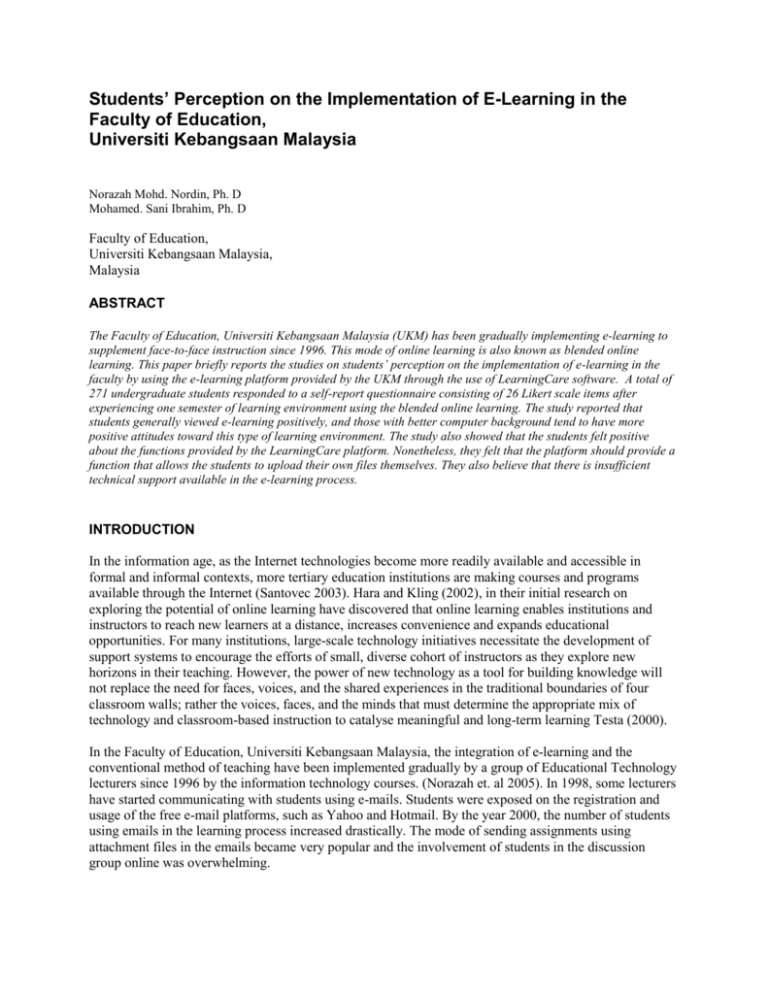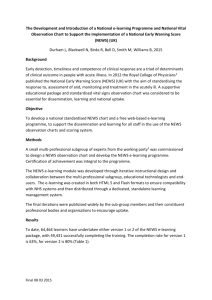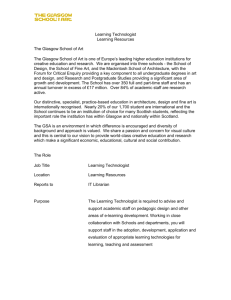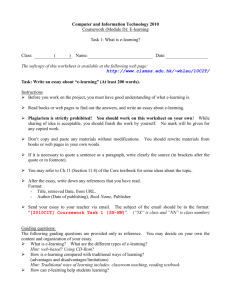
Students’ Perception on the Implementation of E-Learning in the
Faculty of Education,
Universiti Kebangsaan Malaysia
Norazah Mohd. Nordin, Ph. D
Mohamed. Sani Ibrahim, Ph. D
Faculty of Education,
Universiti Kebangsaan Malaysia,
Malaysia
ABSTRACT
The Faculty of Education, Universiti Kebangsaan Malaysia (UKM) has been gradually implementing e-learning to
supplement face-to-face instruction since 1996. This mode of online learning is also known as blended online
learning. This paper briefly reports the studies on students’ perception on the implementation of e-learning in the
faculty by using the e-learning platform provided by the UKM through the use of LearningCare software. A total of
271 undergraduate students responded to a self-report questionnaire consisting of 26 Likert scale items after
experiencing one semester of learning environment using the blended online learning. The study reported that
students generally viewed e-learning positively, and those with better computer background tend to have more
positive attitudes toward this type of learning environment. The study also showed that the students felt positive
about the functions provided by the LearningCare platform. Nonetheless, they felt that the platform should provide a
function that allows the students to upload their own files themselves. They also believe that there is insufficient
technical support available in the e-learning process.
INTRODUCTION
In the information age, as the Internet technologies become more readily available and accessible in
formal and informal contexts, more tertiary education institutions are making courses and programs
available through the Internet (Santovec 2003). Hara and Kling (2002), in their initial research on
exploring the potential of online learning have discovered that online learning enables institutions and
instructors to reach new learners at a distance, increases convenience and expands educational
opportunities. For many institutions, large-scale technology initiatives necessitate the development of
support systems to encourage the efforts of small, diverse cohort of instructors as they explore new
horizons in their teaching. However, the power of new technology as a tool for building knowledge will
not replace the need for faces, voices, and the shared experiences in the traditional boundaries of four
classroom walls; rather the voices, faces, and the minds that must determine the appropriate mix of
technology and classroom-based instruction to catalyse meaningful and long-term learning Testa (2000).
In the Faculty of Education, Universiti Kebangsaan Malaysia, the integration of e-learning and the
conventional method of teaching have been implemented gradually by a group of Educational Technology
lecturers since 1996 by the information technology courses. (Norazah et. al 2005). In 1998, some lecturers
have started communicating with students using e-mails. Students were exposed on the registration and
usage of the free e-mail platforms, such as Yahoo and Hotmail. By the year 2000, the number of students
using emails in the learning process increased drastically. The mode of sending assignments using
attachment files in the emails became very popular and the involvement of students in the discussion
group online was overwhelming.
In 2003, the UKM Computer Center had introduced the LearningCare software, the UKM Learning
Management System to be utilised by the university. This paper describes the studies on students’
perceptions on the implementation of LearningCare in the Faculty of Education, UKM.
E-LEARNING
The idea of using computer to assist training of people started long ago like the use of Computer-based
Training (CBT). Since the invention of the Internet and various digital media, this idea of using these
media for education experience emerges as what is call e-learning today. Many universities or
organizations have implemented some forms of e-Learning system to extend their education or training
online.
According to Tan (2003), e-learning is the use of technology to enhance educational experience. It
includes Computer-based Training, Web-based Training (WBT), digital collaboration and virtual
classroom, delivered via the Internet, intranet, extranet, e-books, and CD-ROMs etc. Chanda and Kumail
(2002) envision e-Learning as a universe comprising three basic elements: content, services and
technology According to them, as in the case of conventional learning, content forms the backbone of eLearning. The technology forms the rider on which the content flows and the service is the support system
that leads a human touch to the process of learning via the Internet.
E-LEARNING MODEL
According to Henry (2000) and Tan (2003), throughout all of the confusion and consistency of the diverse
definitions of e-learning, there is a general acceptance of key elements of ‘total’ e-learning solution that
comprises Content, Technology, Service and Technology. This model is shown in Figure 1. One of the
key success factors for an e-Learning program is the integration of these elements. Due to the vast variety
of e-learning solutions, achieving a well integrated e-learning program has long-term impacts on an
organization.
Technology
Content
Service
Strategy
Figure 1 The E-Learning Model
Technology
Technology infrastructure refers to the Internet, Intranet, mobile or hybrid delivery platform capable of
synchronous and asynchronous access. The infrastructure includes Web hosting and services, database,
Internet access, use of video technology like video-on-demand and video conferencing.
Content Development Tools
These tools range from word processing tools like MS Word and Power Point to Web authoring tools like
Authorware, Dreamweaver, Flash and Director. These tools are essential to convert content into electronic
content for online use.
Learning Management System (LMS)
LMS is a software or Intranet system that automates the administration of training events. The LMS
registers users, tracks courses in a catalog, and records data from learners and provide appropriate reports
to management. Some LMS includes online assessment, personalization and other resources. Examples of
LMS are LearningSpace (IBM), Blackboard (Blackboard, USA), LearningCare (Universiti Kebangsaan
Malaysia), Quickplace (Universiti Malaysia Sarawak).
Service
If technology is the backbone of an e-learning program, services are activities that link facilitators, users
and the managers together on this backbone. Services are required in the running of an e-learning
program. Services are in the form of content creation and delivery, facilitator support, marketing,
launching, facilitation, monitoring, assessment, collection of user feedback, newsletter, and any form of
ongoing support to users of an e-learning program.
Strategy
While e-learning services are activities that link facilitators, users and management together, strategies are
principles, thought and methods on how to use the resources and services in order to achieve the learning
objectives. The two levels of strategies that are important to an e-learning program are Learning Strategy
and E-learning Strategy. Learning Strategy includes the use of pedagogy, instructional design principles,
way of delivery, level of interaction and participation, level of facilitation, level of resource support, and
type of collaboration model in order to achieve the objectives of an e-learning program for a particular
group of users (Stephenson, 2001). On the other hand, E-learning Strategy refers to the building of an elearning culture, reusability of the created content, relating of e-learning to knowledge management.
Content
In e-learning scenario, Content refers to the digital content which is being accessed by both content
creators and users. The types of content for e-learning program are off-the-shelf content, customer-made
content, and self-authored content.
LEARNING MANAGEMENT SYSTEM IN UKM: LEARNINGCARE
LearningCare is a software or a platform, which currently used by the UKM to supplement the face-toface teaching and learning process. The LearningCare has a number of functions to facilitate the entire
operations and management of the e-learning program in the UKM. The functions available include
Portfolio Information, Announcement, Assignment, Forum, News, Links, Documents, Notes, References,
Learning Tracks, and Assessment as shown in Figure 2, Figure 3 and Figure 4.
Figure 2: LearningCare
Figure 3: LearningCare: Forum
Figure 4: LearningCare: Announcement
After experiencing one semester of learning environment using the blended online learning with
LearningCare, a total of 271 undergraduate students at the Faculty of Education, UKM responded to a
self-report questionnaire consisting of four parts:
Part A: Demography, Part B: A set of 26 Likert scale
items (1=Strongly Disagree, 2=Disagree, 3= Less Agree, 4= Agree, and 5 = Strongly Agree), Part C:
Open-ended questions on problems faced by the students when using the LearningCare and Part D: The
Strength of the LearningCare. Descriptive statistics include frequency count and mean score were used in
the data analysis of Part B, which consists of items on each of the functions available for students (Forum,
Quizzes, Lecture Notes, Digital Presentation, External Links, Assignments, Internal Links,
News/Bulletin, Announcements, Portfolio Information, and References). A mean score between 0-1.75 is
categorized as a very negative response, a mean score between 1.76-2.50 is categorized as a negative
response, a mean score between 2.51-3.25 is categorized as a moderately positive response, a mean score
between 3.26-4.00 is categorized as a positive response and a mean score between 4.01-5.00 is categorized
as a very positive response.
Table 1 shows the mean scores for the 26 items on Part B evaluating the functions used by the students in
the learning process: i. Forum, ii. Quizzes,.iii. Lecture Notes, iv. Digital Presentation, v. External Links,
vi. Assignments, vii. Internal Links, viii. News/Bulletin, ix. Announcements, x. Portfolio Information, and
xi. References. As a whole, all respondents (n=271) showed positive reaction toward the integration of
LearningCare in the teaching and learning process. The respondents strongly agree that all the functions in
the LearningCare are suitable for the courses that they are taking. They also agree that all functions in the
LearningCare have helped them access information and respond on the topics discussed, increase and
measure the level of their understanding of the topics discussed, make early preparation prior to the
lecture, access latest information on this course, and provide clear picture on the course.
Data analysis from Part C have shown that about 70% of the students face problem on technical support.
They believe that there is insufficient technical support available in the e-learning process. Results from
Part D, the strength of LearningCare, reveal that LearningCare has helped them practice the independent
learning since it is available anyway, around the clock. However, they dissatisfy on the absence of
function on LearningCare that would give them the authority to upload their own file themselves.
Functions
Forums
1
2
Quizzes
3
4
5
6
7
Lecture Notes
8
Digital
Presentations
9
10
11
External Links
Assignments
Internal Links
News/ Bulletin
12
13
14
15
16
17
18
19
20
Announcements
21
22
Portfolio
Information
23
24
References
25
26
Items
Mean
The Forums are suitable for this course
The Forums have helped me access information and respond on
the topics discussed
The Quizzes used are suitable for the course
The quizzes developed in this course have helped me increased
my understanding
The quizzes developed in this course have helped me measure
the level of understanding
The lecture notes provided are suitable for this course
The lecture notes provided enable me to give full concentration
during the lecture because I do not have to copy notes when the
lecture is on
The lecture notes provided have helped me make early
preparation before the lecture
The digital presentations used are in suitable for this course
The digital presentations enable me to give full concentration
during the lecture because I do not have to copy notes when the
lecture is on
The digital presentations have helped me make earlier
preparation prior to the lecture
External links provided are suitable for this course
External links provided enable me to broaden my reading scope
External links provided have saved my time in identifying
related links of a topic assigned
Assignments given are suitable for this course
Assignment requirements are clear
Internal links given are suitable for this course
Internal links provided are focused to the course structure
News/ Bulletin provided are suitable for this course
News/ Bulletin enable me to access latest information on this
course
Announcements are suitable for this course
Announcements provided enable me to access the latest
information on the lecture
Portfolio Information provided is suitable for the course
Portfolio Information enables me to have clear picture on the
course
References used are suitable for this course
References provided are useful in gaining further information on
the related topic.
4.12
Table 1 Students’ Perception Toward LearningCare
4.02
4.12
4.06
4.15
4.02
4.23
4.16
4.23
4.15
4.32
4.18
4.21
4.11
4.28
4.03
4.09
4.26
4.32
4.21
4.25
4.23
4.26
4.09
4.08
4.34
CONCLUSION
LearningCare is an e-Learning platform, an effort undertaken by the UKM to integrate e-Learning into the
conventional face-to-face teaching and learning process in the university. The results of the study reveal
that students in the Faculty of Education, UKM believe that all functions available in the LearningCare are
suitable for the courses that they are taking and have helped them access information and respond on the
topics discussed, increase and measure the level of their understanding of the topics discussed, make early
preparation prior to the lecture, access latest information on this course, and provide clear picture on the
course. However, the students feel that Learningcare should have a function that would allow them to
upload their own files themselves. They also believe that there is insufficient technical support available in
the e-learning process. As a whole, planning and developing e-learning platform for use beyond the
immediate setting require unique design strategies. The design of the LearningCare should consider such
attributes as sustainability or the ability to maintain, revise or otherwise provide the technical support so
that the platform developed will continue to be available and of value to students and lecturers of UKM
overtime.
REFERENCES
Blackboard Inc.., (2003) Homepage of Blackboard Inc. Retrieved March 1, 2003 from
http://www.blackboard.com
Chanda, G & Kumail, S.M.N. (2002). eLearning : An Expression of the knowledge
economy. A highway between concept and practice. New Delhi: Tata McGraw-Hill
Hara, N., & Kling, R. (2001). Student distress in Web-based distance education.
EDUCAUSE Quarterly, 3.
Henry,, P. (2001). E-Learning Technology, Content and Services. Education and
training, Vol. 43 No. 4, 2001 (249-255)
Santovec, M.L. (2003). Faculty development. Distance Education Report, 7 (2),8.
Stephenson, J (2001). Teaching & learning Online: Pedagogies for New Technologies. London: Kogan
Page.
Testa, A.A. (2000). Seven principles for good practice in teaching and technology. In R.
Cole (Ed.), Issues in Web –based pedagogy: A critical primer (pp.237-245). Westport, CT: Greenwood
Press.
Tan, Y.G. (2003). Educational Web-publishing: Design, creation and management, Singapore: Pearson,
Prentice Hall.







